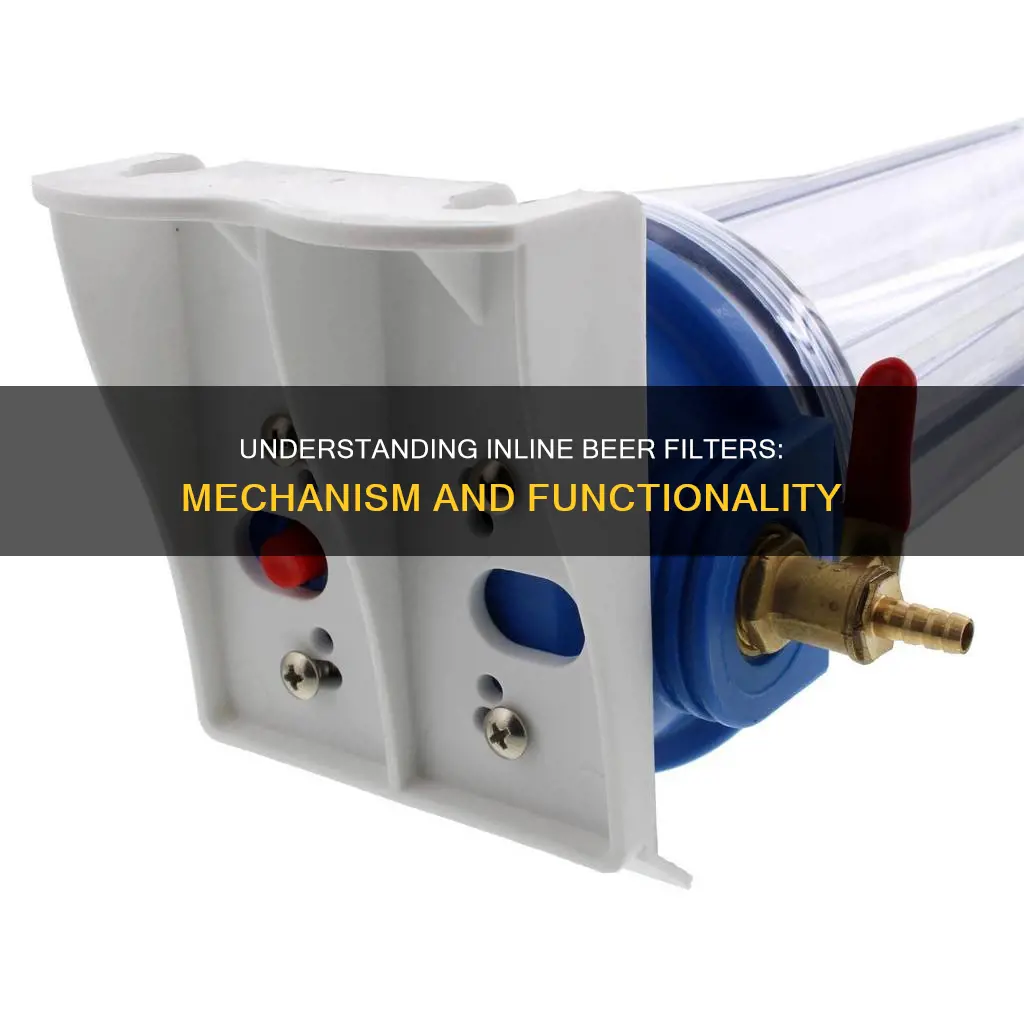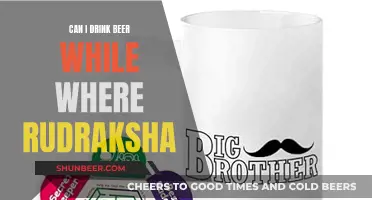
Inline beer filters are used to improve the taste and clarity of beer by filtering out ingredients, barrel char, fine carbon particles, and even flies during transfer and bottling. They are designed to be compatible with the high alcohol content of spirits and can also be used to protect heat exchangers. Inline beer filters are easy to clean and can also be used by brewers in hot-side applications.
| Characteristics | Values |
|---|---|
| Purpose | Remove sediment, improve taste and clarity of beer |
| Use | Connects directly to transfer line, gravity-fed |
| Compatibility | High alcohol content of spirits, heat exchangers |
| Operating temperature | Up to 100C/212F |
| Ease of cleaning | Very easy to clean compared to frame and plate filters |
| Reusability | Reusable, custom-moulded from high-quality thermoplastic and T304 stainless steel |
| Downsides | May get blocked during transfer of super hoppy beers |
What You'll Learn
- Inline beer filters can be used to filter beer during transfer to a secondary container, like a keg or bottle
- They can be used to remove sediment, like hops, yeast, and other particulates
- They can be used to infuse beer with ingredients like hops or fruit
- They can be used to protect heat exchangers
- They can be used to filter out ingredients, barrel char, carbon particles, and more during bottling

Inline beer filters can be used to filter beer during transfer to a secondary container, like a keg or bottle
The Bouncer Beer Filter is a highly effective and simple-to-use inline beer filter that cleans and clears beer. It comes in two sizes: the standard Bouncer and the Bouncer MD, also known as the Mac Daddy. The filter connects directly to the transfer line and can be used with two filters in sequence, with the first having a larger micron and the second a smaller micron. The Bouncer Beer Filter improves the taste and clarity of beer by filtering out ingredients, barrel char, fine carbon particles, and more. It is built to last and can be used repeatedly, custom-moulded from high-quality thermoplastic and T304 stainless steel. It is easy to use and clean, with fewer parts to clean and sanitise.
Another option is the Beer Filter Kit - 10 in. Canister Filter, which can be installed inline between two ball lock Cornelius kegs, using CO2 pressure to push the beer out of the full keg through the filter and into the clean keg. This kit includes a 1-micron 10" spun poly sediment filter, fittings for connection to the filter housing, 3' of beverage line, clamps, and two beverage out ball lock quick disconnects. The spun-polypropylene filters are disposable and cannot be reused, but one filter can be used for multiple kegs.
Inline beer filters can also be used for infusing beer, with some filters doubling as infusers.
Beer Diet: Does It Work or Is It a Myth?
You may want to see also

They can be used to remove sediment, like hops, yeast, and other particulates
Inline beer filters are used to remove sediment, such as hops, yeast, and other particulates, to improve the clarity and taste of the beer. They are placed in the transfer line between two kegs, and the beer is forced through the filter using CO2 pressure. The filter material may be an integral part of the filter housing or a removable cartridge.
There are several types of filters available, but it is recommended to stay away from simple water filters as they are not designed to handle beer yeast and sediment. Most homebrewing filters are single-use paper filters with either a canister or plate layout. Plate-style filters are preferable as they offer a wider surface area and are less prone to clogging.
The size of the filter is also important. To remove all yeast and sediment, a 1-micron filter is needed, but this is prone to rapid clogging. A two-stage filter with a coarse 3-5 micron filter and a finer 1-micron filter is a better option. Filters are rated by the average size of the particles they will filter, and polypropylene is the most common filter material.
Before using a filter, it is important to sanitise it and run plain water through it to flush it out. This will also help identify any leaks. It is also recommended to filter the beer cold if possible as this will remove more haze.
The Magic Behind Draft Beer: Bar System Explained
You may want to see also

They can be used to infuse beer with ingredients like hops or fruit
Inline beer filters can be used to infuse beer with ingredients like hops or fruit. The Bouncer Beer Filter, for example, can be used as a Randall to infuse hops or other ingredients into your beer when serving. The BouncerMD Inline Beer Filter can also be used as a Randallizer to infuse hops or other ingredients into your beer. The Bouncer Beer Filter comes in two sizes: the standard Bouncer and the Bouncer MD, which stands for "Mac Daddy". The Bouncer MD comes with two sets of fittings, one for 3/8" ID hose and the other for 1/2" ID hose, so you can select the size that matches your siphon or brew kettle valve. The larger Mac Daddy filter also gives you 224% more filter surface area than the base model.
The Bouncer Beer Filter can be used to infuse beer with ingredients in three basic ways:
- Out of the brew kettle: Connect the filter to your brew kettle valve with standard tubing, or cut your siphon tube line near the top and insert the barbs into the tube.
- Out of the fermenter: Cut your siphon tube near the top and push the barb ends into the tubes, paying attention to the flow direction arrow. The barb ends fit a standard siphon.
- Out of your serving tap: Hack a mini Randall out of your bouncer by adding ingredients like orange peels, cracked coffee beans, or cloves to your beer.
The Bouncer Beer Filter can also be used to remove sediment, improve the taste and clarity of your beer, and save time and beer. It is easy to use and clean, with fewer parts to sanitize, and it pays for itself in a few batches.
Beer Batters: How Do They Work?
You may want to see also

They can be used to protect heat exchangers
Inline beer filters can be used to protect heat exchangers. Heat exchangers are a critical piece of brewing equipment that is often overlooked in terms of maintenance. They are used to flash cool wort on its way to the brewery cellar, and if not properly maintained, they can become a point of infection.
One way to protect heat exchangers is to use inline beer filters, which can help remove particulate fouling and prevent the build-up of organic matter, lime deposits, and other soiled materials. By regularly cleaning the heat exchanger and using inline beer filters, brewers can ensure that their equipment is protected and that their beer is clear and free of sediment.
Additionally, inline beer filters can also be used in conjunction with other cleaning methods such as manual cleaning, chemical cleaning, and clean-in-place (CIP) systems to further protect heat exchangers and ensure effective sanitation.
Exploring Beer Enhancement With Bazooka Tubes
You may want to see also

They can be used to filter out ingredients, barrel char, carbon particles, and more during bottling
Inline beer filters can be used to filter out a variety of ingredients and particles during bottling, resulting in clearer beer. Some common substances that can be removed include ingredients, barrel char, carbon particles, yeast, sediment, and even flies!
The Bouncer Beer Filter, for example, is a highly effective and simple-to-use inline filter that can be attached directly to your transfer line. It comes with different-sized filters, such as the red filter with a larger micron size and the blue filter with a smaller micron size, to catch both larger and smaller pieces of sediment.
Another option is the Beer Filter Kit - 10" Canister Filter, which can be installed inline between two ball lock Cornelius kegs. This kit includes a 1-micron filter, which is considered fine filtration and will result in clear beer as long as there is no starch haze.
Using inline beer filters during bottling can help improve the clarity and taste of your beer, making it a useful option for homebrewers who want to achieve clear, sediment-free beer without having to wait for natural processes to work.
The Science Behind Fizzics Beer: How Does It Work?
You may want to see also
Frequently asked questions
An inline beer filter improves the taste and clarity of your beer by filtering out sediment, dry hops, fruit, yeast, etc. during the transfer and bottling process.
Inline beer filters are typically used after fermentation, while you are transferring your beer to a secondary container, keg, or bottles.
Inline beer filters connect directly to your transfer line. Multiple filters can be used in sequence, with each filter designed to catch particles of different sizes. The filters are easy to set up and clean, and they can also be used as infusers.
Inline beer filters save time and beer, improve the taste and clarity of your beer, and are easy to use and clean. They are a simple and effective way to get clear beer without the need for cold crashing or additives.
One potential downside is that highly hopped beers may block the filter during transfer. However, this can be easily addressed by rinsing and sanitizing the filter halfway through the transfer.







